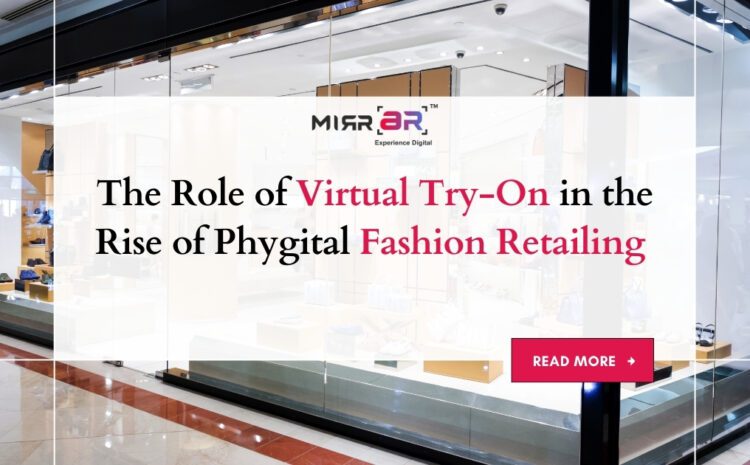In the ever-evolving world of fashion retail, the boundaries between physical and digital experiences are rapidly blurring. Enter “phygital” — a fusion of physical and digital retailing designed to offer consumers the best of both worlds. At the heart of this transformation lies Virtual Try-On (VTO) technology, revolutionizing how customers engage with fashion. Tools like MirrAR’s VTO platform are helping retailers enhance in-store and online shopping experiences, shaping the future of phygital commerce.
What is Phygital Fashion Retail?
Phygital retail is an innovative approach that combines physical touchpoints (brick-and-mortar stores) with immersive digital technologies like AR (Augmented Reality), AI, and VTO. It’s not just about having an online and offline presence — it’s about creating seamless interactions between the two.
For fashion brands, this means offering customers the ability to touch and feel products in-store while accessing digital enhancements such as size prediction, instant product comparisons, style suggestions, and of course, virtual try-ons. It’s personalization, convenience, and immersion — all rolled into one.
Virtual Try-On: Bridging Physical and Digital Worlds
The pandemic accelerated the need for remote shopping experiences. But even as footfall returned to stores, customers began demanding digital conveniences in their physical visits too. That’s where Virtual Try-On steps in.
Using MirrAR’s advanced VTO technology, shoppers can now try on clothes, jewelry, eyewear, and even bridal wear virtually — whether they’re browsing in-store or online. This allows for a hyper-personalized and interactive shopping journey that mimics the tactile appeal of traditional retail while adding the speed and variety of digital platforms.
In-Store Enhancements Through VTO
One of the key ways VTO supports phygital fashion is by enhancing in-store experiences. Smart mirrors and AR kiosks powered by MirrAR let customers visualize how items will look on them without needing to physically try them on. This reduces waiting times, minimizes inventory touchpoints, and helps retailers optimize floor space.
For instance, a luxury jewelry store using MirrAR’s AR-enabled mirror can showcase hundreds of SKUs digitally, allowing customers to try everything from diamond necklaces to bangles in seconds — no handling, no physical display limitations.
Enriching E-Commerce with Physical Precision
Conversely, VTO infuses a sense of physical presence into online shopping. Using their smartphone cameras or webcams, users can try on outfits or accessories virtually, gaining confidence before purchasing.
This not only reduces return rates — a major cost burden in fashion e-commerce — but also empowers brands to provide a near-realistic feel of fit and appearance. With MirrAR’s no-code platform, retailers can embed these experiences into their own websites without complex development.
Driving Engagement and Conversion
Virtual Try-On technology is not just a novelty. It significantly boosts engagement, session times, and, most importantly, conversion rates.
Consumers are more likely to purchase when they feel confident about how a product will look on them. VTO turns window shoppers into buyers. By integrating AI to suggest complementary items, brands can also increase average cart values through upselling and cross-selling.
Moreover, VTO-enabled phygital experiences offer shareable content — try-ons can be saved and shared on social media, organically expanding brand reach.
Phygital is the Future — And VTO is the Key
In the age of instant gratification, phygital fashion retail powered by VTO offers speed, personalization, and innovation. It’s no surprise that global luxury brands are racing to adopt this hybrid model.
Brands that embrace virtual try-on not only future-proof themselves but also build deeper customer relationships by providing more meaningful, data-rich, and seamless experiences. Tools like MirrAR’s 3D AR Configurator, Mirrar LIVE, and its Metaverse capabilities take this vision even further, allowing brands to operate across digital platforms while keeping human touchpoints intact.
Conclusion
Virtual Try-On is no longer a futuristic gimmick — it’s a strategic enabler for the phygital transformation in fashion retail. By merging the tactile authenticity of physical stores with the limitless potential of digital interfaces, VTO technology allows brands to redefine customer journeys.
As the fashion world marches toward a new normal, retailers equipped with MirrAR’s suite of tools are leading the charge, delivering immersive, intuitive, and impactful shopping experiences. For brands looking to stand out in a crowded market, VTO is not just a trend — it’s the cornerstone of the next era in retail.
